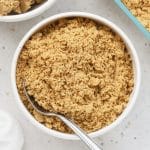Description
Learn 5 of the BEST ways to soften brown sugar for baking. (The bread method is my favorite!)
Ingredients
- Hard brown sugar
- A slice of bread, paper towels, or a terra cotta disc, as needed by your method.
Instructions
Microwave Method (Fastest)
- Place the hard brown sugar in a large microwave-safe bowl.
- Get a few paper towels wet and squeeze out the extra water so they’re damp but not dripping.
- Cover the hard brown sugar with the damp paper towels and microwave 10-15 second increments at a time, stirring or using a fork to break the sugar up in between intervals. Repeat until the sugar is easy to break apart with the fork. This can take up to a few minutes to work completely, but if you’re patient, it’ll feel like magic!
Oven Method
- Place the hard brown sugar in an oven-safe container (a pie pan, sheet pan, or baking dish works best!)
- Gently heat at 250 degrees F. for 3-5 minutes or so, stirring every few minute with a fork to break up any large pieces.
- Watch carefully so the sugar doesn’t melt!
Bread Method
- Place a piece of bread in a container or bag with hard brown sugar.
- Leave the bread in overnight (at least 8 hours, up to a day), then remove the bread and discard it. Your sugar should be magically soft! (Depending on how hard the sugar is, it may be soft enough to use after a couple of hours)
- Keep In Mind: You need to use FRESH bread, not stale bread for this trick to work, since the sugar needs to draw the moisture out of the bread. If your bread is dry, there won’t be moisture for the sugar to absorb! Also, be sure to discard the bread after 24 hours so it doesn’t mold.
Food Processor Or Grater Method
- If using a box grater, place the grater on a plate or in a large bowl. Use the large sides of a box grater to shave or break up the hardened brown sugar. (Be VERY careful if using this method!)
- Or, put the hard brown sugar in a food processor or blender and pulse the sugar in short, quick bursts to break up any large clumps. (This is safer than the box grater!)
Terra Cotta Method
- Start with a terra cotta medallion/disc. Soak the terra cotta disc in warm water for 20-30 minutes. Remove it from the water and blot off any excess water with a paper towel or clean kitchen towel so you don’t accidentally melt the brown sugar with water.
- Place the terra cotta circle in an airtight container or bag with the brown sugar and leave it for about a day. Use a fork to help you break up any remaining clumps and store the brown sugar with the terra cotta piece to help keep it moist. This usually keeps brown sugar soft for 3-6 months, but you can repeat this soaking & storing method as needed to keep your brown sugar soft.
To Keep Brown Sugar Soft
-
Use An Airtight Container Or Bag. Try to eliminate as much air as possible by using an airtight container or a zip-top bag with any excess air pressed out. I recommend a container that fits the sugar as snugly as possible, so there isn’t a lot of extra air trapped in the container with it.
-
Try A Terra Cotta Disc. Once your sugar is soft, you can use a terra cotta disc to keep the sugar soft. (Soak it for 20 minutes, blot excess water, then add it to the sugar for 3-6 months)
-
Avoid Light And Heat. Don’t store your brown sugar near the stove to avoid heating the sugar. Ideally, you’ll store brown sugar in a dark, cool area (like a pantry, in a cupboard, or in opaque containers).
-
Use It! Lastly, try to use open containers of brown sugar in a timely way. Keep an eye on expiration dates, and use your oldest brown sugar first.
Notes
Gluten-Free Note: If you’re gluten-free or baking for someone who is, ONLY use gluten-free bread for this trick. If you’ve used regular bread/wheat bread, this sugar is no longer safe to use for those with Celiac disease or gluten intolerance.
- Category: Tutorial
- Cuisine: American

